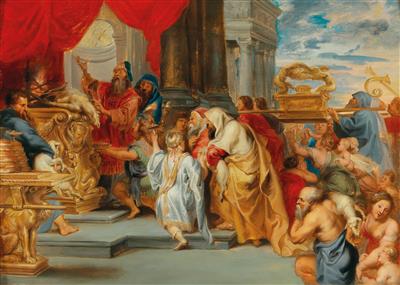Studio of Peter Paul Rubens

(Siegen 1577–1640 Antwerp)
The Sacrifice of the Old Covenant,
oil on panel, 43.5 x 60.6 cm, framed
The present painting is a workshop variant based on a modello by Rubens (Museum of Fine Arts, Boston) that in turn was the sketch for a large canvas destroyed by a fire in 1731, and which was used as a cartoon for a tapestry of the cycle known as The Triumph of the Eucharist (Convent of the Descalzas Reales, Madrid, see N. de Poorter, Corpus Rubenianum Ludwig Burchardt, The Eucharist Series, II, London/Philadelphia 1978, vol. I, pp. 307–319, nos. 10, 10b, figs. 144, 146). Rubens’s modelli have been perennially prized for their freedom of execution in the expression of his ideal. Peter Paul Rubens coped with his overwhelming workload with the help of a highly professionally organised workshop, particularly during his maturity in the second Antwerp period. Apart from a few exceptions it has not been possible until today to identify the individual collaborators in the works that were executed jointly. We are grateful to Bert Schepers of the Rubenianum, Antwerp, for suggesting an attribution to Frans Wouters on the basis of a photograph. Wouters worked in Rubens’s studio and produced a number of variations of the work of his master.
What makes it so difficult to differentiate between the respective hands is that the workshop assistants emulated Rubens’s style to such an extent that they are no longer recognisable as individual artists. This also holds true for such important personalities as Anthony van Dyck. This characteristic work division enabled Rubens to complete even substantial commissions in a homogeneous style and to sell these collaborative efforts as autograph paintings. As a rule, the differentiation between workshop and autograph, which is common today, was not made by contemporaries then, apart from a few exceptions. What mattered most was the creative implementation of a pictorial invention and that the work originated in Rubens’s studio.
Esperto: Dr. Alexander Strasoldo
 Dr. Alexander Strasoldo
Dr. Alexander Strasoldo
+43 1 515 60 403
old.masters@dorotheum.com
24.04.2018 - 17:00
- Prezzo realizzato: **
-
EUR 40.965,-
- Stima:
-
EUR 30.000,- a EUR 40.000,-
Studio of Peter Paul Rubens
(Siegen 1577–1640 Antwerp)
The Sacrifice of the Old Covenant,
oil on panel, 43.5 x 60.6 cm, framed
The present painting is a workshop variant based on a modello by Rubens (Museum of Fine Arts, Boston) that in turn was the sketch for a large canvas destroyed by a fire in 1731, and which was used as a cartoon for a tapestry of the cycle known as The Triumph of the Eucharist (Convent of the Descalzas Reales, Madrid, see N. de Poorter, Corpus Rubenianum Ludwig Burchardt, The Eucharist Series, II, London/Philadelphia 1978, vol. I, pp. 307–319, nos. 10, 10b, figs. 144, 146). Rubens’s modelli have been perennially prized for their freedom of execution in the expression of his ideal. Peter Paul Rubens coped with his overwhelming workload with the help of a highly professionally organised workshop, particularly during his maturity in the second Antwerp period. Apart from a few exceptions it has not been possible until today to identify the individual collaborators in the works that were executed jointly. We are grateful to Bert Schepers of the Rubenianum, Antwerp, for suggesting an attribution to Frans Wouters on the basis of a photograph. Wouters worked in Rubens’s studio and produced a number of variations of the work of his master.
What makes it so difficult to differentiate between the respective hands is that the workshop assistants emulated Rubens’s style to such an extent that they are no longer recognisable as individual artists. This also holds true for such important personalities as Anthony van Dyck. This characteristic work division enabled Rubens to complete even substantial commissions in a homogeneous style and to sell these collaborative efforts as autograph paintings. As a rule, the differentiation between workshop and autograph, which is common today, was not made by contemporaries then, apart from a few exceptions. What mattered most was the creative implementation of a pictorial invention and that the work originated in Rubens’s studio.
Esperto: Dr. Alexander Strasoldo
 Dr. Alexander Strasoldo
Dr. Alexander Strasoldo
+43 1 515 60 403
old.masters@dorotheum.com
|
Hotline dell'acquirente
lun-ven: 10.00 - 17.00
old.masters@dorotheum.at +43 1 515 60 403 |
| Asta: | Dipinti antichi |
| Tipo d'asta: | Asta in sala |
| Data: | 24.04.2018 - 17:00 |
| Luogo dell'asta: | Wien | Palais Dorotheum |
| Esposizione: | 14.04. - 24.04.2018 |
** Prezzo d’acquisto comprensivo dei diritti d’asta acquirente e IVA(Paese di consegna Austria)
Non è più possibile effettuare un ordine di acquisto su Internet. L'asta è in preparazione o è già stata eseguita.
